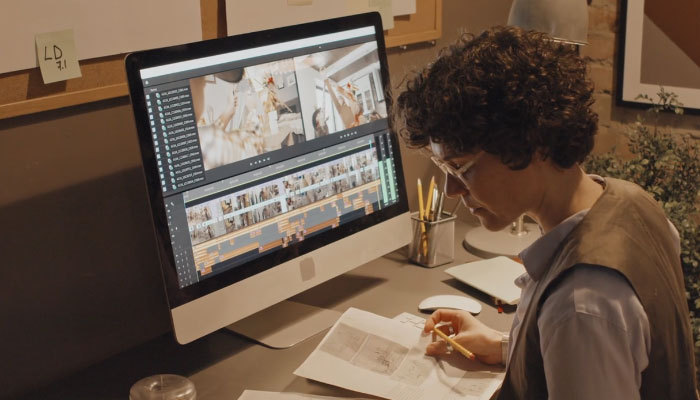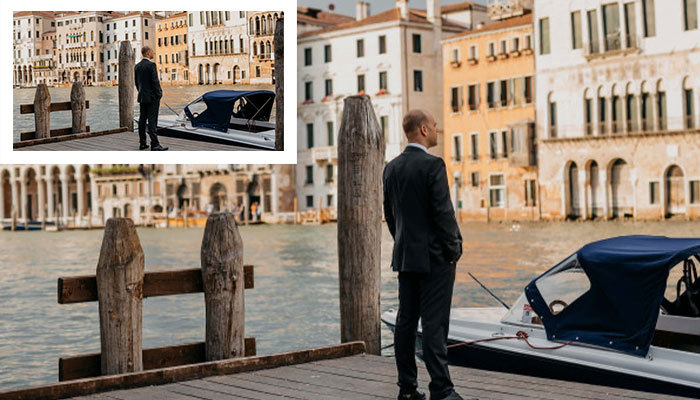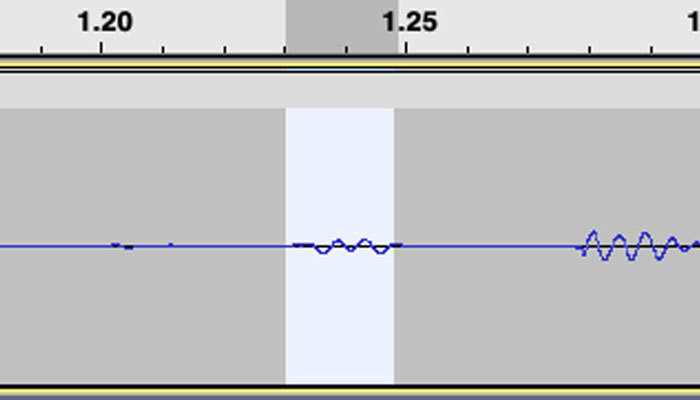Art of the Cut is excited about our new home on the Boris FX blog!
I’ve been using Boris FX and Sapphire for more than 20 years and I’m proud to partner with them to bring you great filmmaking content that is inspirational, aspirational, entertaining, and will hopefully give you the skills to move your career forward in the direction you've been dreaming about.
Art of the Cut has done more than 350 interviews with the world’s best editors over the last eight years. My name is Steve Hullfish and I make my living as a film, TV, and doc editor, so I hope that the questions I ask are the kinds of questions you’d ask if you had the opportunity to sit down with some of the best editors in the business.
Today’s guest has been in the Art of the Cut hot seat several times and always has a lot to share.
Art of The Cut with Eddie Hamilton Ace on Top Gun Maverick
I’m excited to share my discussion with Eddie Hamilton, ACE about editing Top Gun: Maverick. If you’ve been following the buzz on this movie, the hype is real. Please get to a movie theater as soon as possible to enjoy this one — especially one with a great ATMOS sound system. I will preface this interview by saying SPOILER ALERT. There is no stopping the revelation of important moments throughout this interview. While we tried to avoid the major plot point spoilers, I don’t want to ruin your enjoyment of the movie so you might want to see it before proceeding.
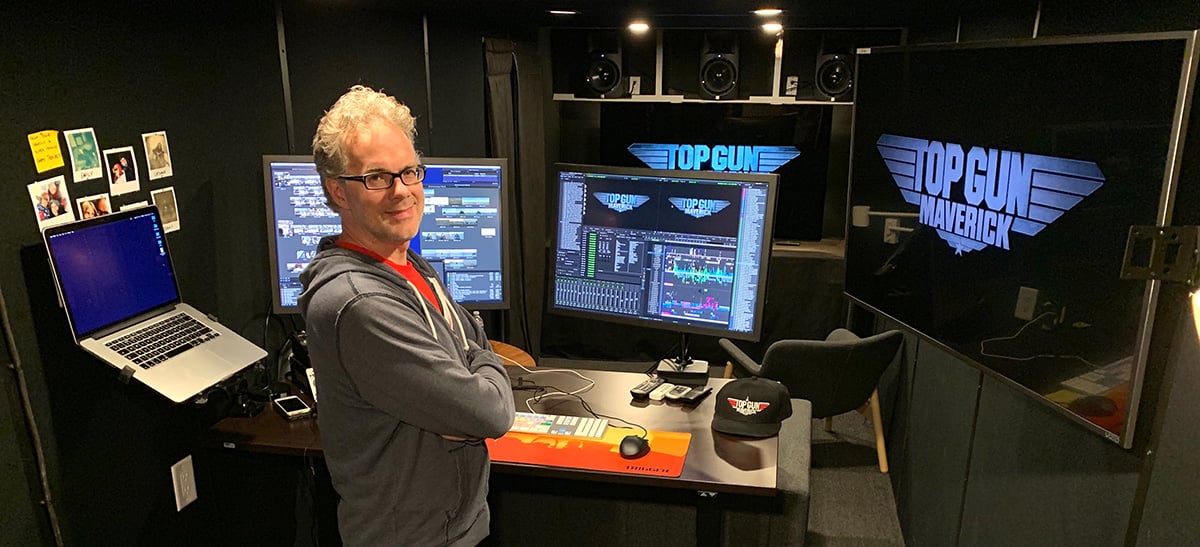
A little about Eddie Hamilton: I last interviewed Eddie for Mission: Impossible — Fallout. We also spoke for Kingsman: The Golden Circle and Mission: Impossible — Rogue Nation. So to say he knows how to cut an action film would be an understatement.
The rest of his filmography includes the films Kick-Ass, Kick-Ass 2, and X-Men: First Class among many others.
Eddie was very generous with his time, so there’s a lot to cover. Let’s get to it.
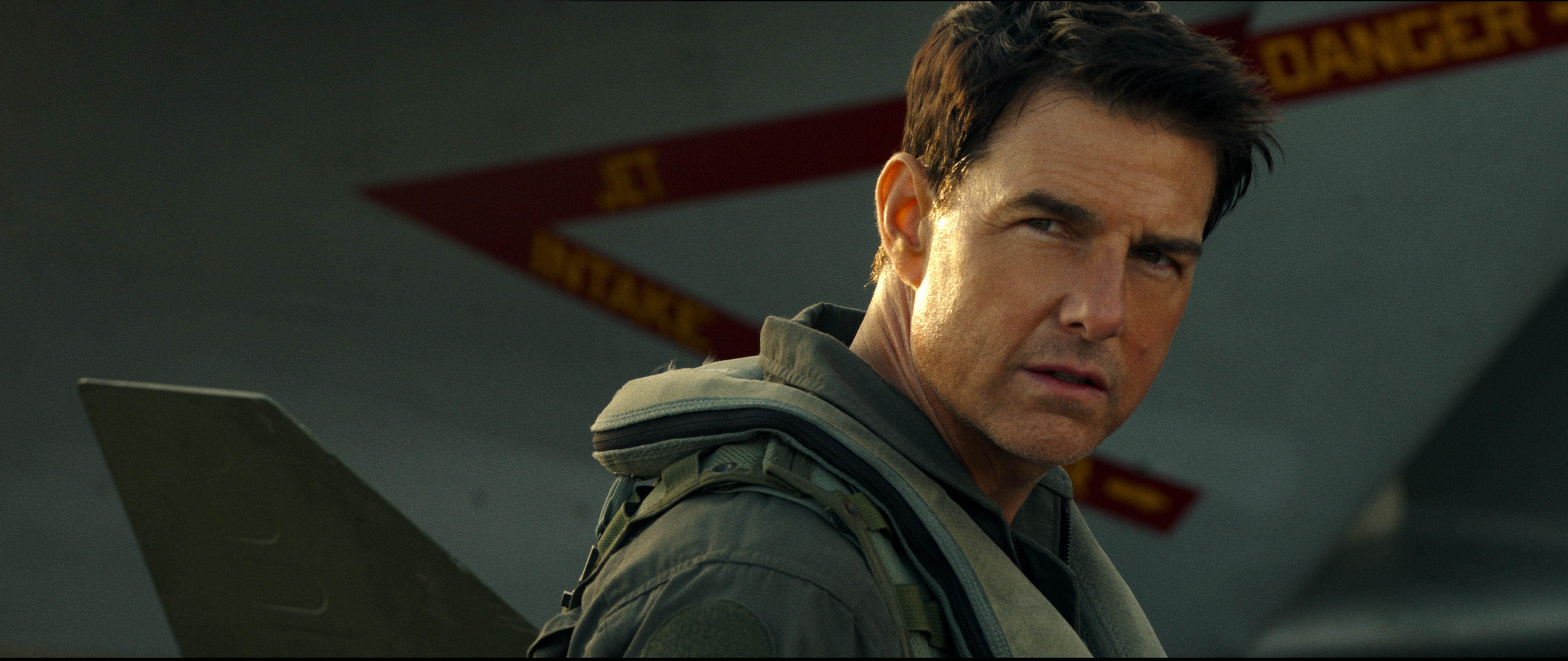
HULLFISH: What a great movie. You must be so proud. This is one of those films you really want to see in the theater.
HAMILTON: I'm so thrilled you're saying that Stephen, I get quite emotional, to be honest. It was a very tough film to work on and the hardest job I've ever done, and with some very dark days in there where I was feeling very overwhelmed and not really being able to kind of climb out and have a bird's-eye view of the film and just feeling stuck in a sequence and not knowing if it's working.
But I remember as a kid going to the cinema and having almost spiritual experiences in a movie theater, where you just are lost in the film and you don't want it to end and it's just distilled movie magic. And people seem to be reacting to Top Gun: Maverick like that where they just absolutely love it and I'm so pleased. Everyone's hard work is paying off.
It was tough. We finished the film in lockdown. So we had a couple of very early test screenings in Florida before lockdown and that was January of 2020. The test screenings went well, but it was before we did pickups, before we had our sound mix, before we had music or the finished score in there. So the movie was really not firing on all cylinders and needed a lot of work, quite frankly, but I remember in one of our little focus groups, there was the guy that who said "I just want to say that Top Gun is my favorite film and there is no film better than Top Gun.” We all looked at each other and thought, “Okay, okay.” All the executives from Paramount and the creative team are there and he said, "I would like to say this film is as good as Top Gun."
We thought, “Okay, we'll take it. That's all we want.” I just don't want fans of the original Top Gun to be disappointed. I swear Steve, every day on the production of this movie, I was feeling that weight of expectation because I'm a fan of movies myself — cinema-going — but I'm also a huge fan of the original Top Gun.
I was 14 when it came out in 1986, the perfect age. I saw it six times in theaters because it ran in theaters for a year because obviously back then, things didn't hit TV or VHS or whatever for a while - like a year or sometimes a year-and-a-half where you'd be waiting for the movie to come out.
If I was sitting down to watch Top Gun: Maverick, I'd have my arms crossed and I'd be thinking, “This is a terrible idea. What are you guys think you're doing making a sequel to Top Gun? You've got no right to do this. It's going to suck. I'm going to hate it before I've even seen a frame.” Tom Cruise, especially, and Joe, both said, “Look, we've got to win people over in the first two minutes of the film.”
And the way that we do that is by starting the movie exactly the same way we started the first film.
Bring up Harold Faltermeyer's theme, bring up the description of Top Gun. The only thing I changed was I changed it to say “men and women,” as opposed to just men, and then let's do the montage and hear the theme and then go into 'Danger Zone'. People will feel like we're respecting the movie that they love and that we're respecting Tony Scott and that we are welcoming everybody back into this world and giving you the feeling of Top Gun straight away.
Then we fade to black and we rediscover Mav elsewhere in his life. We kind of catch up with that character and fill the audience in on everything that's been going on in his life. We wanted people just to relax immediately. Same typeface on the credits — all those details — same drop shadow. We made sure that we used the Tony Scott filters and it's all magic hour and the only thing that's different obviously is the quality of the photography and the sound design and the sound mixing, which has obviously come on a long way.
It's insane. I mean, you're listening to the state-of-the-art in terms of quality of sound design and sound mixing. We didn't cut any corners. There was no compromise made at all. Tom Cruise just said, “This movie has to be sonically perfect. Every second from the beginning to the end, and I'm not compromising on that.” We took a long time to mix the sound. Seven weeks in total, which is twice as long as the average movie. Mark Taylor, the sound mixer, had just done No Time To Die before the lockdown and that was a three-hour movie. They mixed it in three weeks and ours is a two-hour, 15-minute movie and it was seven weeks.
To be in there and to be part of that and feel the movie come alive. What it's like, Steve, when you're editing, you're hearing the sounds in your head and you're hearing the music and you're imagining it. And all these sequences, I was cutting silent with some lines of dialogue, but all the jet stuff, initially, when you're piecing the scenes together, you're just imagining all the sounds of the explosive bursts of energy on each of the effects, like the lion roars that we used and the gunshots and the explosions and all that stuff that you throw into kind of spice up the sound.
It was a treat to be in that theater and hear it. And then to see the reaction from the audience around the world and read reactions on Twitter and read reviews and have people emailing me and texting me, telling me that they've seen it - like you - and just kind of losing their minds. It's so exciting and I'm so grateful and I'm just utterly thrilled that we did it. We did what we set out to do, which is deliver a great night out at the movies for fans of the original movie and fans and people who haven't seen the original movie, so it works for everybody. But anyway, I'm so thrilled. You enjoyed it. Thank you.
HULLFISH: There's a lot to unpack in what you just said. One of the things is the opening credit montage to get the audience on board with the movie, and you sent me the first page of the script.
There is not a lot of description of what goes on in there. How do you — when you're faced with kind of a formless scene — start?
HAMILTON:
Sometimes starting is the hardest thing when you're editing a scene, because you think, “What do I start on?” Because the moment you have a shot on the timeline that shot has its own internal energy and speaks to you about when the rhythm is right to cut to another shot.
So starting is quite often the hardest thing. I remember I had watched the original Top Gun and they did something very similar, which is, you want to feel kind of jets starting to move out onto the deck of the aircraft carrier and you want to choose images that are slightly impressionistic and full of texture. And heat haze and just cool, heavy, long lens, technology, wheels and guns and missiles and wings and cockpits and pilots doing cool stuff. So I had about 15 hours of footage for the first pass of the opening montage and it was four days of photography on the USS George Washington in July 2018.
So Joe Kosinski and Claudia Miranda went and filmed for four days, just deck activity. Quite a lot of it was not magic hour because they don't do much at sunset because it's bad visibility for the pilots and all that. I was really trying to steal shots, which didn't feel too top-lit and too kind of mid-day.
Some of them are still in there, but we managed to find some stuff, which was kind of not too kind of midday lit, top-lit. But I remember looking through, and as I was breaking the shots down, we were breaking them down according to kinds of activity and how people are pointing and saluting or catapults being loaded and all that stuff in the back of my mind, I was always thinking what's going to be the first shot of this scene? Like when we fade up from black, what is it going to be?
And I remember seeing a shot of some jets, like three jets stacked up on a long lens, taxiing out and just thinking that feels like the opening shot. And then when I went back and looked at Top Gun, the original did something very similar. They found a shot of some long lens wheels taxiing out and then it's just a case of allowing the images to kind of reveal more and more of the activity and the geography on the deck.
Also, you're looking just for kind of cool compositions and the way that the light bounces off the cockpit and then you're looking to see deck activity and the magic is trying to find something where the guys on the deck, they know they're being filmed, so sometimes they're a little self-conscious. So you're trying to find stuff where they're just natural.
And I remember it probably took around two weeks to build the first pass of that montage. And we showed it to Paramount Pictures, but before the main unit started filming on the ground story of the movie, we went into the Paramount theater and screened it for the executives. Tom was there and he introduced everybody to the cast, but we built the opening title sequence with the correct font and the music and the sound design I stole from the original movie. That was one thing I did do is I got the stems from the digital remaster that Paramount had done.
I think it was in the year, 2000-ish they did a DTS ES surround remix. So it has left, right, and the center surround channels. So it's like 6.1 as opposed to 5.1. I had all those tracks and one of the first things I asked my team to do was break out all the different jet sounds and write descriptions of them. We built a library of sounds from the original movie that I could use of afterburners and engines warming up and catapults launching and all that cool stuff. That montage stayed for at least a year, it stayed untouched in the edit because it worked.
It did its job. And there was so much else to do on the movie. In April 2019, they went back to another aircraft carrier and they filmed Tom Cruise launching off the deck for real, in an F18, which is one of the shots we use right at the beginning of the third act of the movie. They filmed four more days of deck activity there.
We were able to get a lot more stuff of people saluting and pointing and the lighting was better and they were able to get more interesting camera positions. So we're putting cameras right near where the jets take off and stuff. It must've been February 2020. So a year and a half after we started, I took another two days and went through all that additional footage - started to revisit the sequence and started to spice it up even more with more cuts and more activity and every other great shot that I'd found from the second load of photography.
It just started to really hum and just be alive with activity. Tom said, "You have to feel like this is the coolest job in the world and wherever you are, you just want to be on that aircraft carrier ‘cause it's awesome to be amongst those cool pilots and everyone doing their jobs really well and all this amazing technology being used to launch these guys into the air.”
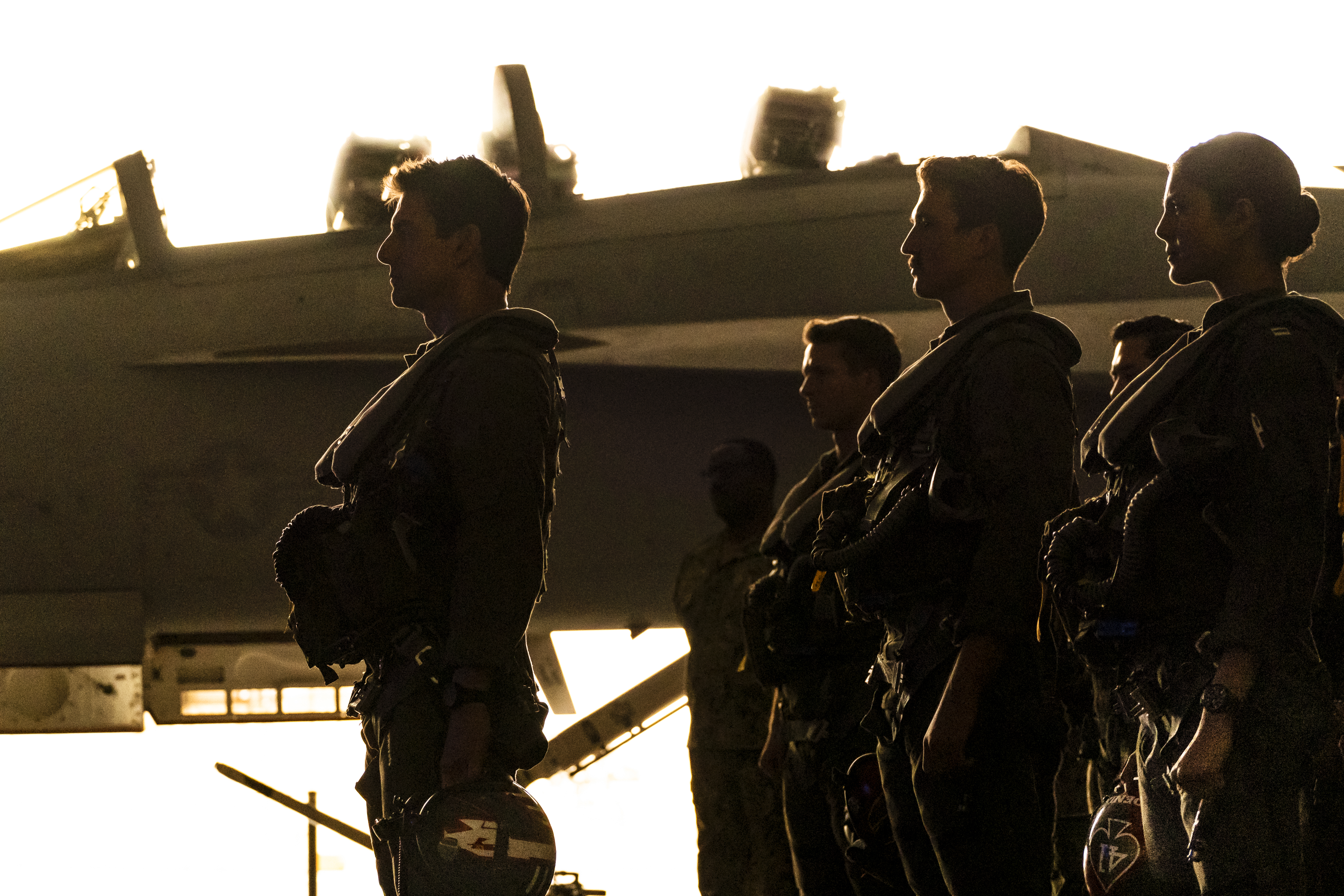
So I think we managed to capture that. Then they managed to go inside the little bubble on the deck where the guy's launching all the catapults and controlling them all, so you got more of a sense of the deck activity than when you've got in the first movie, cause we were able to get cameras in more interesting places.
The trick is, Steve, just keep putting shots on the timeline, regardless of how shit it is, until you get to the end of something, and then you can go back and start refining it, but it's always getting something down on the timeline for the first time that's the hardest thing. And that goes for all the aerial sequences in the movie, it was just an overwhelming amount of footage and choices and angles.
How are we going to tell this story? But you have to not worry that it's any good and you have to just start putting shots on the timeline and then worry about making it really tight and exciting later and know that it's going to take months. That's the other thing: you can't rush it when there's that much footage to explore, you've got to give yourself time to be thorough with it. I'm probably like you. I'm a very thorough editor because that's what kind of, what you're paid to do.
Tom Cruise walks into the cutting room and he wants to look at me and know that I've been through it all and I've picked what I think are the best shots. And the other thing I do is that I deliver options. I'll have five or six stacked up for almost every moment in a sequence. If you don't like this angle, how about these five other options which kind of tell a similar story with how the jets are moving or they're just slightly different geography? Providing those options is a way of evolving a sequence quickly with producers or directors.
Providing those options is a way of evolving a sequence quickly with producers or directors. When the director is in the room and they're saying, "Can you show me what else you've got?” You've got stuff stacked up. I had quite a large team of assistants who were all brand new to me. I had to hire them all because I moved to LA to work on the film. I didn't have any of my usual London team.
One of the assistants I hired was Laura Creecy, I brought her on really knowing that she had some editorial experience and there was a point where I was so overwhelmed with footage, I said, "Laura, I think you should be promoted to be associate editor on the film and I want you to start building these sequences. Find all the moments. Break down every aerial sequence by all the beats that we discussed on the day as we were filming.”
So she made these gigantic timelines, which took her weeks and weeks and weeks of work. And then I said, just start throwing shots together because I don't have any time to edit anything. I'm watching so much coverage every day just to know: “Did we get the emotional beat or did we not get it?”We went to six different Naval bases over months and months of filming in the first half of 2019, filming almost all aerial photography and what we did was we did interiors of the jets first. So we started to build up a library of the pilots inside, but we didn't film the exterior shots of the jets until a long while later, so having all the material to tell the story took such a long time that initially it was hard to build the sequences. Sometimes we'd slug in a storyboard.
Sometimes we'd put in bits of previs. We did try and previs some sequences like the Dark Star sequence from the beginning of the movie was previs-ed and we actually use a lot of that in the movie and the shots evolved into the shots that are in there now, because that you could plan that because the plane doesn't actually fly.
We would get jet models on wooden sticks and we would film them on an iPhone doing maneuvers, literally. It's what the pilots would discuss in the briefings every morning, they would get these planes on wooden sticks and they would say, "I'm going to be in front. You're going to be on my five o'clock, I'm going to do a hard left bank. You're going to follow me down". Then we would film it on an iPhone and sometimes even edit together a very rough animatic of what the sequence was intended to be, which was always way too long. All of these scenes that we filmed were like four times longer than they are in the finished movie because everything in the movie has to be dynamic and exciting constantly.
Whereas when you're flying planes, it's not dynamic and exciting constantly. It's dynamic for very short bursts of action. And then the planes take a while to settle down and then they line up on each other and then they can start doing other movements. The actual photography of the jets doesn't really match the previs very closely at all. You're filming jets flying 700 miles an hour on a very long lens from a helicopter or another jet or the ground. You kind of get what you get, but it gives you this very immediate energy in the shots because the camera's trying to find the jets in the air. So you get like really fantastic foreground sometimes. If the clouds are out — if there are clouds in the sky — you get a lot of cloud movement.
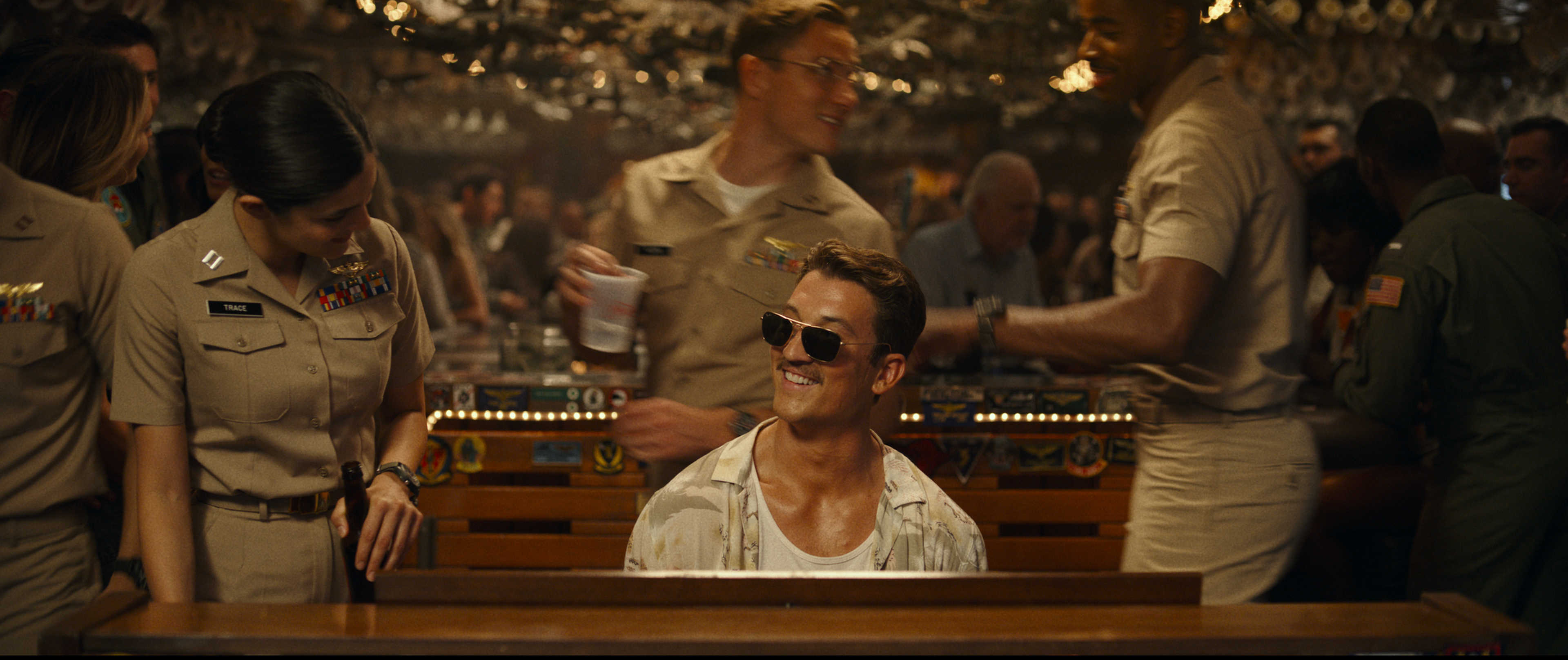
HULLFISH: Let's talk about a couple of other things. Editorially speaking, there's a really fun montage of Miles playing “Great Balls of Fire.” It's a big party scene. Fun, happy, energetic. And then it takes a pretty severe tonal shift. How do you deal with those tonal shifts in editorial?
HAMILTON: You are constantly asking yourself: “Whose point of view?” The movie's called Top Gun: Maverick. A lot of Tom Cruise movies are very subjective experiences. So you are subjectively experiencing the emotion of the movie through the main protagonist. Who is Maverick? Who is Tom Cruise? And most of his movies are single protagonist stories. Even Mission Impossible, to an extent— which is a team film— is still mostly following Ethan Hunt and his emotional journey through the movie. So for a sequence like that, we've spent a long time in the Hard Deck bar.
We're with Maverick almost exclusively through the entire sequence — even when we're with Hangman and Rooster and Phoenix - we're still introducing the characters by pivoting around Maverick at the bar. We're feeling that he's watching these pilots from across the bar with Penny there and when Hangman comes over and says, "Can I have four more on the old-timer?" Penny gives them a little smile. But you feel Maverick in the sequence throughout and when Hangman and Payback throw him out of the bar, we stay outside with the character and we're playing everything subjectively from his point of view.
So you feel the crowd behind the closed doors of the bar and Maverick's excluded from that for a bit. Then you hear “Great Balls of Fire” strike up. We're on the back Tom and we just spend a moment with him as listens and then we see him walk up to the window. But again, we're in his point of view at all times. So the tonal shift comes because the character is experiencing an emotion. We're always rooting ourselves in how Maverick is feeling at that moment.
He sees Rooster playing the piano and then we cut to a closeup and we see these flashback of Maverick and Goose from the first movie and the boy Bradley on the piano. You get reminded of the story of Maverick and Goose and what happened. It's so interesting because for people who've seen the original Top Gun, those images of Maverick holding Goose in the water instantly trigger the feeling that you had when Goose died in the first film.
We use Harold Faltermeyer’s “Memories” theme played on a French horn. The sound is distant and echoey and we're putting you in Maverick's point of view. That's all it is. So constantly through the movie we are finding ways to center the audience in Maverick's point of view and experience the emotions of each scene through that character.
That was a good example of that. You come out of that little sequence and he's looking at the pilots and he's thinking, "What's going to happen to them all?" Tom said - in the mission brief earlier - “Someone's not coming back from this.” When Tom Cruise says that in a scene, he's normally telling you the truth. We're basically planting the seed in the audience's mind that one of the characters is not going to come back and he's looking at them all. He's thinking, “If I don't help these kids it's not going to go well.”
We used to have a scene where — after that you saw Maverick pick up the phone and call Cyclone — he said, "I'm in, I'll see you at the hangar tomorrow" but we didn't need it. It was all self-explanatory. So we leave it with Penny realizing that there's something up between Maverick and Rooster. We play the very end of that moment. We go into Penney's point of view, just for four or five shots and then we actually end the scene with Maverick backing away. We fade to black there and we cut straight to the hanger the next morning and we hear, "Attention on deck!" and then the pilots are in the classroom.
We obviously didn't need that scene where Maverick made the phone call because it was quite clear to the audience that he turns up. He's made the decision. Then there's that delicious moment where Hangman and Coyote and Payback realize: “That's the guy we threw out of the bar the night before.” That’s the guy who's going to be teaching them.
It's a kind of straightforward editorial answer — which is: “Whose point of view are you in?” Which is a key question that editors ask themselves constantly. Whenever they're looking at a sequence, it's: “Who am I identifying with?” Especially if it's a single protagonist movie. We had coverage on everybody for every scene — don't get me wrong — but when you're choosing who to give weight to — dramatic weight— when you're choosing who to give a closeup to, there's a pyramid. Maverick at the top and then Rooster and maybe Hangman.
The central relationship of the movie is Maverick and Rooster and how are they going to resolve their differences and when are they going to resolve their differences. We can discuss the when of that. We tried lots of options of when they resolved their differences and compared the emotional effect it would have at different points in the third act of the movie.
Ultimately we decided that they would only resolve it on the deck of the carrier once they'd got back from the mission. So you get that right at the end of that sequence where they're hugging on the carrier deck. Then Maverick allows the emotion of that whole experience to flood out.
When I cut back to Maverick's reaction, in order to extend the moment, I'm using his reaction to Rooster saying the line. So if you watch, you can see Rooster saying the line again in the closeup, over Rooster's shoulder to Maverick, because we needed to extend that moment. So just a little nerdy editing thing to keep an eye out for is that you can see that we used that trick because Tom gave such a great performance there.
You just want a real moment for the emotion, the relief, and you've experienced everything that's happened between him and Rooster and that's all playing out on his face and the relief of the fact that they've seeing eye-to-eye and they've resolved their differences and he's going to be able to be a father figure to Rooster again, which he has failed to do successfully, obviously, up to that point. But all of that emotion just pours out of Tom at that moment. So we needed to extend it and allow the music to do its job there.
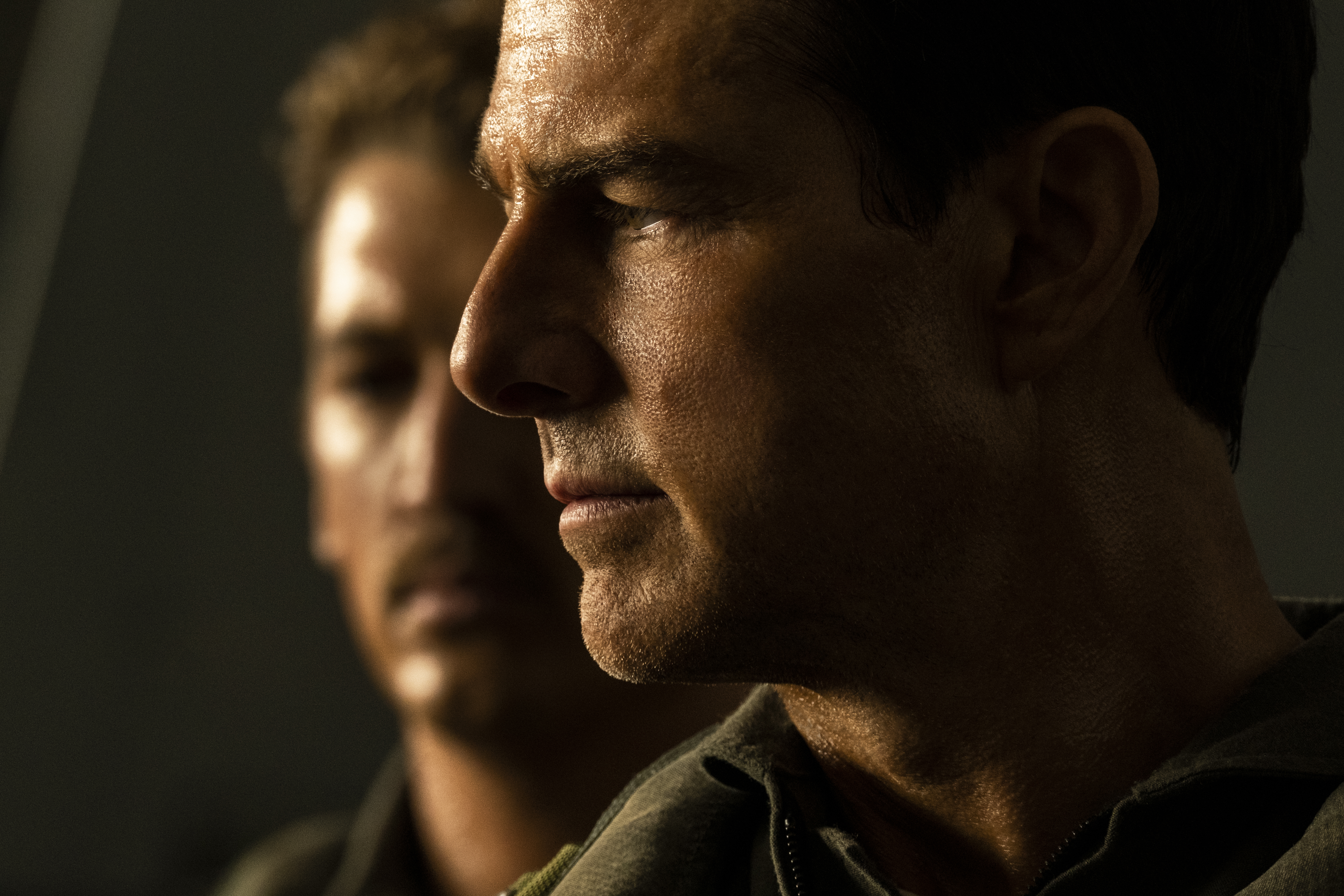
HULLFISH: There is some bravery as an editor to do that. People could detect it but I never noticed that his lips were moving. I've done that trick a million times. I think many editors have.
HAMILTON: Everyone listening to this has done it.
HULLFISH: Right. You needed to extend that moment. And so you have to say, “No one will notice the lips. Don't worry about the lips.” I'm guessing also in that scene, there's so much background movement and the camera might've been handheld that you couldn't do a typical split-screen. Because many people would do a split screen.
HAMILTON: We've had many, many, many many split screens in this movie. I did a lot of them and a lot of re-timing of performances and playing reactions in slow motion and all the tricks that you do to get the emotional ride completely smooth. But we did a lot of split-screens but it wasn't possible in that because there is a lot going on in the frame. I don't mind it being old school, where back in the day if you're cutting work print, which, obviously, the original Top Gun was edited on 35 mil, which is an astonishing achievement when I know how hard it was for me to edit all these action sequences.
A lot of people have said this, but the central premise of the third act mission is to fly down a trench and drop a bomb in a tiny three-meter exhaust port right below the main port, which is...
HULLFISH: What does that sound like? (The trench run in Star Wars)
HAMILTON: Exactly. Several times I went back and watched the original Star Wars: Episode Four climactic, dogfight and trench run to get a sense of: “how did they do it back then?” Again, Marcia Lucas worked on that sequence predominantly and had Richard Chew and Paul Hirsch there as well, but Marcia, I think, worked on it mostly.
I just had a massive amount of respect when I went back and rewatched that and how they did it because I was struggling to make the third act kind of feel like it didn't have air in it. It was much, much, much longer at one point. We were desperately trying to figure out ways to compress it and get it so that you were just literally on the edge of your seat the entire time. But sometimes when you're doing these editorial tricks, you just want to leave it like it was in the old days because we can watch The Godfather or we can watch Goodfellas, or we can watch any number of classic movies where those tricks are being used constantly. You never notice because you're in the emotion of the scene. Sometimes you just want to leave a little bit of old-school analog not fixed in the film because you're thinking: “I don't have to… I can't really fix it in this case.” It's nice for people who care about that or are curious about studying editing to see those tricks being used on these big movies where you'll
